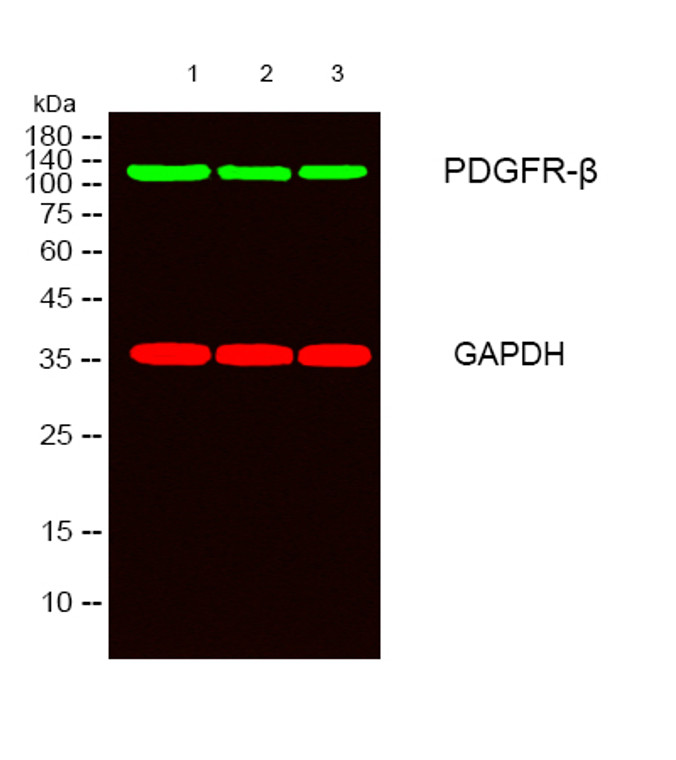| Host: |
Rabbit |
| Applications: |
WB/IHC/IF/ELISA |
| Reactivity: |
Human/Mouse/Rat |
| Note: |
STRICTLY FOR FURTHER SCIENTIFIC RESEARCH USE ONLY (RUO). MUST NOT TO BE USED IN DIAGNOSTIC OR THERAPEUTIC APPLICATIONS. |
| Short Description: |
Rabbit polyclonal antibody anti-Platelet-derived growth factor receptor beta (718-767 aa) is suitable for use in Western Blot, Immunohistochemistry, Immunofluorescence and ELISA research applications. |
| Clonality: |
Polyclonal |
| Conjugation: |
Unconjugated |
| Isotype: |
IgG |
| Formulation: |
Liquid in PBS containing 50% Glycerol, 0.5% BSA and 0.02% Sodium Azide. |
| Purification: |
The antibody was affinity-purified from rabbit antiserum by affinity-chromatography using epitope-specific immunogen. |
| Concentration: |
1 mg/mL |
| Dilution Range: |
WB 1:500-1:2000IHC-P 1:100-300ELISA 1:20000IF 1:100-300 |
| Storage Instruction: |
Store at-20°C for up to 1 year from the date of receipt, and avoid repeat freeze-thaw cycles. |
| Gene Symbol: |
PDGFRB |
| Gene ID: |
5159 |
| Uniprot ID: |
PGFRB_HUMAN |
| Immunogen Region: |
718-767 aa |
| Specificity: |
PDGFR-Beta Polyclonal Antibody detects endogenous levels of PDGFR-Beta protein. |
| Immunogen: |
The antiserum was produced against synthesized peptide derived from the human PDGF Receptor beta at the amino acid range 718-767 |
| Function | Tyrosine-protein kinase that acts as cell-surface receptor for homodimeric PDGFB and PDGFD and for heterodimers formed by PDGFA and PDGFB, and plays an essential role in the regulation of embryonic development, cell proliferation, survival, differentiation, chemotaxis and migration. Plays an essential role in blood vessel development by promoting proliferation, migration and recruitment of pericytes and smooth muscle cells to endothelial cells. Plays a role in the migration of vascular smooth muscle cells and the formation of neointima at vascular injury sites. Required for normal development of the cardiovascular system. Required for normal recruitment of pericytes (mesangial cells) in the kidney glomerulus, and for normal formation of a branched network of capillaries in kidney glomeruli. Promotes rearrangement of the actin cytoskeleton and the formation of membrane ruffles. Binding of its cognate ligands - homodimeric PDGFB, heterodimers formed by PDGFA and PDGFB or homodimeric PDGFD -leads to the activation of several signaling cascades.the response depends on the nature of the bound ligand and is modulated by the formation of heterodimers between PDGFRA and PDGFRB. Phosphorylates PLCG1, PIK3R1, PTPN11, RASA1/GAP, CBL, SHC1 and NCK1. Activation of PLCG1 leads to the production of the cellular signaling molecules diacylglycerol and inositol 1,4,5-trisphosphate, mobilization of cytosolic Ca(2+) and the activation of protein kinase C. Phosphorylation of PIK3R1, the regulatory subunit of phosphatidylinositol 3-kinase, leads to the activation of the AKT1 signaling pathway. Phosphorylation of SHC1, or of the C-terminus of PTPN11, creates a binding site for GRB2, resulting in the activation of HRAS, RAF1 and down-stream MAP kinases, including MAPK1/ERK2 and/or MAPK3/ERK1. Promotes phosphorylation and activation of SRC family kinases. Promotes phosphorylation of PDCD6IP/ALIX and STAM. Receptor signaling is down-regulated by protein phosphatases that dephosphorylate the receptor and its down-stream effectors, and by rapid internalization of the activated receptor. |
| Protein Name | Platelet-Derived Growth Factor Receptor BetaPdgf-R-BetaPdgfr-BetaBeta Platelet-Derived Growth Factor ReceptorBeta-Type Platelet-Derived Growth Factor ReceptorCd140 Antigen-Like Family Member BPlatelet-Derived Growth Factor Receptor 1Pdgfr-1Cd Antigen Cd140b |
| Database Links | Reactome: R-HSA-1257604Reactome: R-HSA-186763Reactome: R-HSA-186797Reactome: R-HSA-2219530Reactome: R-HSA-5673001Reactome: R-HSA-6811558 |
| Cellular Localisation | Cell MembraneSingle-Pass Type I Membrane ProteinCytoplasmic VesicleLysosome LumenAfter Ligand BindingThe Autophosphorylated Receptor Is Ubiquitinated And InternalizedLeading To Its Degradation |
| Alternative Antibody Names | Anti-Platelet-Derived Growth Factor Receptor Beta antibodyAnti-Pdgf-R-Beta antibodyAnti-Pdgfr-Beta antibodyAnti-Beta Platelet-Derived Growth Factor Receptor antibodyAnti-Beta-Type Platelet-Derived Growth Factor Receptor antibodyAnti-Cd140 Antigen-Like Family Member B antibodyAnti-Platelet-Derived Growth Factor Receptor 1 antibodyAnti-Pdgfr-1 antibodyAnti-Cd Antigen Cd140b antibodyAnti-PDGFRB antibodyAnti-PDGFR antibodyAnti-PDGFR1 antibody |
Information sourced from Uniprot.org
12 months for antibodies. 6 months for ELISA Kits. Please see website T&Cs for further guidance











